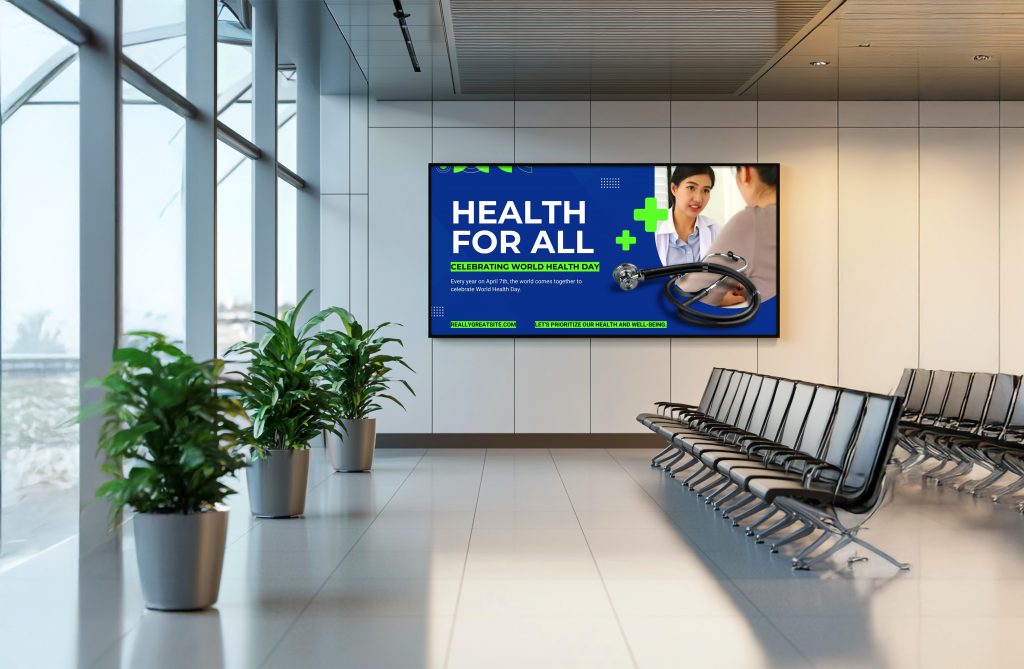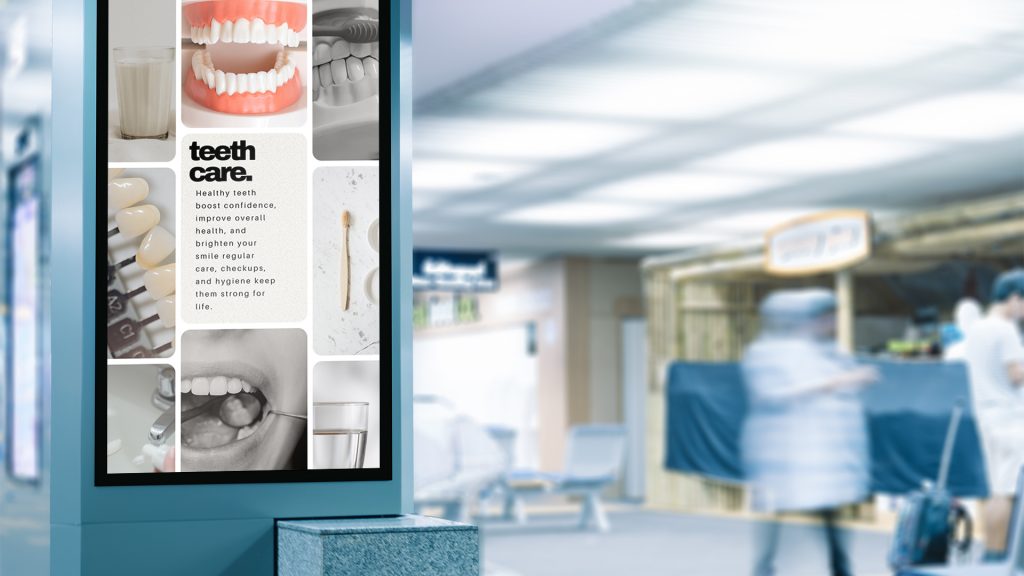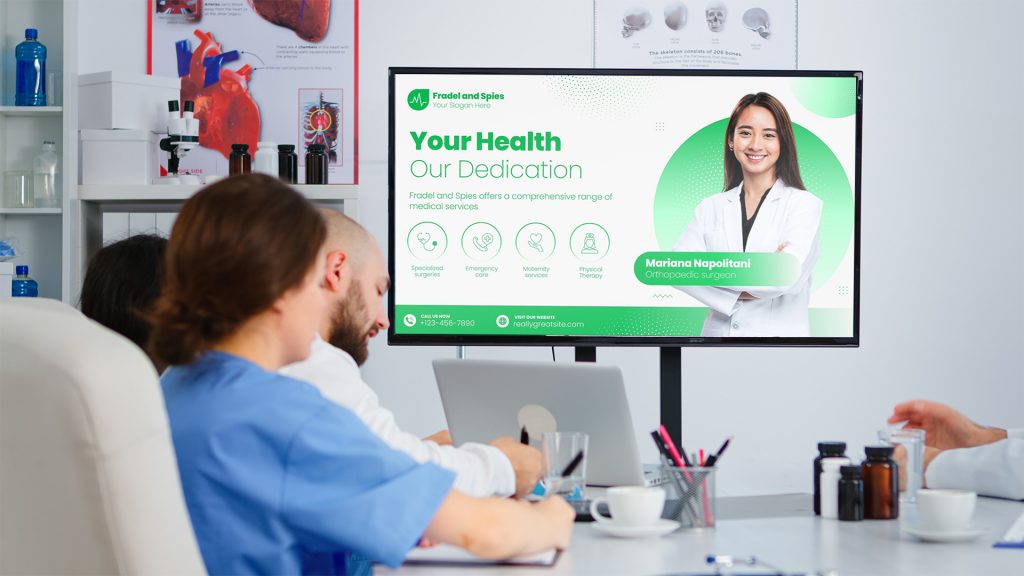Healthcare digital signage is changing the way hospitals communicate with their patients, staff, and visitors. These digital signs have replaced outdated bulletin boards and static posters. This technology provides solutions to key challenges, including reducing patient anxiety, improving operational efficiency, and fostering trust through transparent communication.
Healthcare digital signage is a dynamic display that shows content related to a particular healthcare facility. These displays can be used for various operations like wayfinding, real-time content, enhancement in patient experience, and much more.
Hospital administrators can use these healthcare digital signage to enhance patient experiences and streamline operations. From providing clear wayfinding to instant schedule updates, smart displays serve everyone, making the hospital environment more navigable and efficient.
This guide dives into practical strategies for implementing effective Hospital digital signage solutions, showcasing how interactive displays improve communication, automate announcements, and boost operational flow. Healthcare digital signage is no longer optional; it’s a critical step toward modern, patient-centered care.
Transforming Patient Communication Through Healthcare digital signage
Real-time appointment updates reduce waiting room anxiety

Healthcare digital signage transforms the waiting room by providing dynamic displays that offer real-time updates on wait times, appointment delays, and queue positions. This empowers patients with the ability to manage their expectations and make informed decisions about their time. Additionally, these displays enhance the experience by showcasing videos promoting a healthy lifestyle.
Healthcare digital signage eliminates the uncertainty that creates frustration in medical facilities. When patients see their appointment status update in real time, stress levels decrease significantly. The technology allows healthcare facilities to communicate delays immediately, explaining whether the delay is due to an emergency or a scheduling adjustment. This transparency builds trust between patients and healthcare providers.
Some advanced healthcare digital signage systems integrate with patient check-in processes, automatically updating displays as patients arrive and progress through various stages of their visit.
Imagine a large, busy medical center in a major city was struggling with patient frustration. Long wait times in the emergency department and outpatient clinics were the biggest source of complaints. Patients felt stressed and uninformed, and staff were constantly interrupted to answer the same questions: “How much longer?” or “What’s my number?”
As a solution to this problem, the hospital installed a healthcare digital signage in its waiting rooms. These displays showed real-time updates on wait times, a dynamic queue with patient numbers, and explanations for delays. The screens also displayed health tips and a few calming nature videos to reduce the waiting room anxiety.
Due to this step, the hospital saw a 30% reduction in perceived wait times. Patients reported feeling more relaxed and in control. The digital displays also freed up staff, who could now focus on direct patient care instead of managing the queue. It was about making the waiting experience more tolerable and transparent, which directly built trust between the hospital and its patients.
Interactive wayfinding eliminates confusion and saves time
Modern healthcare facilities often have complex mazes, with multiple wings, floors, and departments. Healthcare digital signage serves as an interactive kiosk, helping patients and visitors navigate the complex environment with ease. Touch-screen kiosks provide detailed maps, step-by-step directions, and even estimated walking times to specific destinations within the facility.
These wayfinding solutions reduce the burden on staff members who usually receive a high volume of directional questions throughout the day. These Interactive kiosks can show the quickest routes to departments.
The technology adapts to individual needs, offering different route options based on accessibility requirements or time constraints. Patients can search for specific doctors, departments, or services, receiving customized directions on the account for construction zones, temporary closures, or special events happening within the facility.
Multi-language support improves accessibility for diverse populations
Healthcare digital signage breaks down language barriers that can compromise patient care and understanding. Multi-language displays ensure that critical information reaches every patient, regardless of their primary language or English proficiency level. This feature proves especially valuable in diverse urban healthcare settings where patient populations represent numerous cultural and linguistic backgrounds.
Healthcare digital signage can instantly switch between languages at the touch of a button, providing the same information in Spanish, Mandarin, Arabic, or any other languages common in the local community. This capability extends beyond basic directional information to include health education materials, safety protocols, and appointment instructions.
The technology also supports visual communication methods, incorporating universal symbols and pictographs that surpass language barriers entirely. Audio announcements can accompany visual displays, providing spoken information in multiple languages and supporting patients with varying literacy levels or visual impairments.
Due to these Healthcare digital signage’s multi-language support, patients felt more at ease and were able to navigate the facility independently, reducing their reliance on staff for directions. This not only eased patient’s hustle to find the correct way but also freed up staff time, allowing them to focus on clinical tasks. The hospital saw a 15% increase in patient satisfaction scores directly related to communication and wayfinding. The system also proved invaluable during a seasonal flu outbreak, when it was used to circulate public health warnings and prevention tips in multiple languages simultaneously, ensuring critical information reached the entire community.
Emergency alerts and safety messages ensure immediate awareness
Healthcare Digital signage also serves as an important communication tool during emergencies, capable of circulating urgent messages instantly across entire healthcare facilities. Unlike traditional announcement systems that may be difficult to hear or understand, visual emergency alerts grab attention immediately and provide clear and actionable information.
These displays can show evacuation routes, lockdown procedures, or weather-related safety instructions with color-coded alerts that universally communicate emergency levels. During medical emergencies, digital signs can redirect patient flow away from affected areas while providing alternative routes and instructions.
Beyond crises, healthcare digital signage maintains ongoing safety awareness by displaying hand hygiene reminders, infection control protocols, and seasonal health alerts. These displays can automatically update based on current health threats, such as flu season advisories or COVID-19 safety measures, ensuring that safety messaging remains relevant and timely.
Streamlining Healthcare Operations with Smart Signage Solutions
Automated queue management systems optimize patient flow
Healthcare digital signage transforms how hospitals handle patient queues, creating smoother experiences for everyone involved. Modern queue management systems display real-time wait times, appointment schedules, and department-specific updates directly on digital screens throughout the facility. Patients can track their position in line, receive notifications about delays, and better plan their time while waiting.
These systems connect seamlessly with hospital management software, automatically updating displays when appointments run ahead or behind schedule. Emergencies can trigger immediate alerts, redirecting patients to alternative locations or informing them about service disruptions. The technology reduces crowding at reception desks since patients can easily see their status without asking staff members repeatedly.
Healthcare digital signage queue management also captures valuable data about patient flow patterns. Hospitals can identify peak hours, bottleneck areas, and service delays that impact overall efficiency. This information helps administrators make informed decisions about staffing levels, resource allocation, and facility layout improvements, which leads to shorter wait times, reduced patient anxiety, and better resource management across the healthcare facility.
Staff scheduling displays enhance workforce coordination

Healthcare digital signage strategically placed in staff areas transforms how healthcare teams coordinate daily operations. Real-time scheduling boards show shift assignments, break rotations, and last-minute coverage needs without requiring manual updates or paper postings. Nurses, doctors, and support staff can quickly check their schedules, view department announcements, and stay informed about important updates.
These healthcare digital signage systems, combined with existing staffing software, automatically reflect schedule changes, overtime assignments, and emergency coverage requests. When unexpected situations arise, administrators can instantly circulate messages to all authoritative personnel, ensuring an increase in response times and proper coverage maintenance.
The displays also showcase important safety protocols, compliance reminders, and training announcements that keep staff informed about changing procedures. Department-specific information appears on designated screens, reducing information overload while ensuring teams receive relevant updates. Staff members spend less time searching for schedule information and more time focusing on patient care activities.
Equipment status monitoring prevents operational disruptions
Critical medical equipment requires constant monitoring to maintain optimal healthcare delivery standards. Digital signage systems display real-time equipment status, maintenance schedules, and availability across different departments. These displays connect directly to medical devices, showing battery levels, calibration dates, and operational status updates.
When equipment requires attention, alerts appear immediately on relevant screens, ensuring maintenance teams respond quickly before the problem impacts patient care. The system tracks usage patterns, helping hospitals optimize equipment placement and identify when additional units are needed in high-demand areas.
Preventive maintenance schedules appear on department displays, ensuring staff members know when equipment will be unavailable and can plan accordingly. This anticipatory approach reduces unexpected equipment failures, minimizes service disruptions, and extends the lifespan of expensive medical devices. Healthcare facilities can maintain higher operational efficiency while reducing costly emergency repairs and equipment downtime that affects patient care quality.
Building Patient Confidence Through Transparent Information Sharing
Provider credentials and certifications displayed prominently
Healthcare digital signage transforms how hospitals showcase their medical professional’s qualifications and expertise. Healthcare digital signage positioned strategically throughout facilities highlights physician board certifications, specialized training, and years of experience in an accessible format. These presentations go beyond traditional static posters by incorporating dynamic elements such as rotating profiles of department heads, specialist credentials, and continuing education achievements.
The visual presentation of credentials builds immediate credibility when patients encounter unfamiliar medical staff. Digital boards in waiting areas can feature comprehensive profiles including medical school affiliations, residency programs, and professional memberships. This transparency addresses patient concerns about provider qualifications before treatment begins, creating a foundation of trust that improves the overall care experience.
Patient testimonials and success stories create emotional connection
Real patient experiences displayed through healthcare digital signage create powerful emotional connections that statistics alone cannot achieve. Video testimonials featuring recovered patients sharing their journeys connect deeply with current patients facing similar medical challenges. These authentic stories provide hope and reassurance while demonstrating the hospital’s commitment to positive outcomes.
Healthcare digital signage can rotate through various success stories, covering different departments and treatment types to reach diverse patient populations. Recovery stories from cardiac surgery patients, cancer survivors, and emergency care recipients offer relatable examples that help new patients visualize successful treatment paths. The emotional impact of seeing actual patients describe their positive experiences far exceeds the influence of written reviews or numerical ratings.
Quality ratings and awards showcase institutional excellence
Hospital quality metrics displayed through digital signage provide solid evidence of clinical excellence and patient safety achievements. These displays can showcase national rankings, authorised status, and industry awards in visually compelling formats that patients can easily understand. Real-time quality indicators, such as infection rates, patient satisfaction scores, and clinical outcomes, show the hospital’s commitment to transparency and continuous improvement.
Digital presentations of awards and certifications from recognized healthcare organizations like The Joint Commission, Magnet Recognition Program, or specialty society-approved establish credibility and differentiate the facility from competitors. These displays work particularly well in high-traffic areas where patients and families have time to review information while waiting.
Transparent pricing information eliminates billing surprises
Healthcare digital signage can address one of patients’ biggest concerns by providing clear, upfront pricing information for common procedures and services. Healthcare digital signage showing estimated costs for routine treatments, diagnostic tests, and emergency services helps patients make informed decisions about their care. This transparency reduces anxiety about unexpected medical bills and demonstrates the hospital’s commitment to honest communication.
Price transparency boards can include information about insurance acceptance, payment plans, and financial assistance programs. By displaying this information noticeably, hospitals show respect for patient’s financial concerns and create trust through openness about costs. This approach particularly benefits patients without insurance or those with high-deductible plans who need to budget for medical expenses.
Enhancing Medical Education and Health Awareness
Preventive Care Reminders Promote Proactive Health Management
Healthcare digital signage turns waiting rooms into powerful tools for patient education, delivering targeted preventive care messages when patients are most receptive. Displays automatically adjust content by demographics, appointment type, and seasonal priorities, for example, heart health tips in cardiology or vaccination schedules in pediatrics.
These smart displays offer personalized reminders for screenings, medication compliance, and checkups, using engaging visuals and videos to simplify complex health concepts. Patients can scan QR codes to schedule appointments or access trusted resources.
By supporting key messages throughout the visit, healthcare digital signage helps patients remember and act on preventive care recommendations, promoting better long-term health outcomes.
Seasonal Health Tips Keep Patients Informed Year-Round
Healthcare digital signage delivers timely, relevant health tips that change automatically to seasonal concerns. From flu prevention in winter to sun safety in summer and allergy management in spring, dynamic displays keep patients informed with up-to-date wellness advice.
Smart scheduling lets healthcare facilities plan campaigns while ensuring fresh, targeted content. Displays shift focus as seasons change, highlighting hydration in summer, back-to-school health in fall, and immune support in winter.
With real-time updates, healthcare digital signage responds instantly to health threats, such as flu outbreaks, by promoting symptom guides, vaccination info, and prevention strategies. Regional customization ensures content addresses local risks, like hurricane preparedness or altitude sickness, making seasonal health guidance both relevant and actionable.
Interactive Health Screenings Drive Early Detection
Healthcare digital signage is transforming how facilities offer health screenings and assessments. Interactive touchscreen kiosks guide patients through self-administered questionnaires such as depression, cardiovascular risk, and diabetes prevention tools, helping identify potential health issues early.
These private, easy-to-use digital screenings reduce stigma, deliver consistent evidence-based questions, and automatically calculate risk scores with personalized recommendations. Integrated with appointment systems, they allow patients to instantly book follow-up consultations, improving care continuity and follow-through.
With multi-language support and intuitive interfaces, digital signage ensures accessibility for diverse patient populations, empowering early detection without reliance on direct provider interaction. This technology breaks down barriers, encouraging participation and enabling timely medical intervention.
Measuring Success Through Digital Signage Analytics
Patient Satisfaction Scores Track Communication Effectiveness

Patient satisfaction surveys reveal how well healthcare digital signage communicates essential information to visitors and their families. Hospitals now track specific metrics related to information clarity, wayfinding accuracy, and overall communication satisfaction scores. These measurements show direct correlations between well-placed Healthcare digital signage and higher patient satisfaction ratings.
Digital signage systems capture real-time feedback through interactive touchscreens and mobile QR code surveys. Patients rate the helpfulness of appointment information, department locations, and health education content displayed throughout the facility. This data provides healthcare administrators with concrete evidence of communication improvements and identifies areas where messaging needs refinement.
Wait Time Reduction Metrics Demonstrate Operational Improvements
Digital queue management systems generate precise data on patient flow and wait times across different departments. Emergency rooms, outpatient clinics, and surgical centers monitor average wait times before and after implementing digital signage solutions. The data typically shows significant reductions in perceived wait times when patients receive accurate, updated information about delays and expected service times.
Real-time appointment scheduling displays allow patients to see current delays and make informed decisions about their visit timing. This transparency reduces anxiety and complaints while improving overall patient flow efficiency. Healthcare facilities report average wait time reductions of 15-30% after implementing comprehensive digital signage systems that keep patients informed throughout their visit.
Cost Savings Analysis Proves Return on Investment
Healthcare digital signage analytics demonstrate measurable cost savings across multiple operational areas. Reduced printing costs for temporary signs, decreased staff time spent on directional assistance, and lower patient complaint resolution expenses all contribute to positive return on investment calculations.
Facilities track the reduction in paper-based communication costs, which often represents thousands of dollars annually for large hospital systems. Staff productivity metrics show fewer interruptions for basic information requests, allowing medical personnel to focus on patient care rather than providing directions or answering routine questions that Healthcare digital signage can address automatically.
Administrative costs decrease when digital systems handle routine communications like visiting hour updates, menu changes, and department announcements. These measurable savings, combined with improved patient satisfaction scores, create compelling business cases for expanding healthcare digital signage implementations throughout medical facilities.
Conclusion
In conclusion, healthcare digital signage stands as a crucial innovation in the evolution of hospital communication and operational management. By driving efficiency, enhancing patient awareness, and fostering trust through transparent information sharing, these smart display solutions address both immediate and long-term challenges in healthcare environments. For healthcare administrators aiming to elevate patient satisfaction, streamline operations, and achieve measurable ROI, investing in digital signage is not just a technological upgrade; it’s a strategic necessity.
At the forefront of this digital transformation is Disploy, offering innovative healthcare digital signage solutions created to meet the unique demands of healthcare facilities. With Disploy, hospitals can confidently navigate the future of patient-centered care, use data-driven insights and real-time communication tools that empower staff and patients alike. Embrace the future of healthcare communication with Disploy and unlock a new standard of efficiency, trust, and innovation.
If your organization is ready to explore the immense potential of this innovative healthcare digital signage, we invite you to take the next step. Experience the seamless integration and powerful impact of digital signage risk-free with our exclusive 14-day free trial. There’s no credit card required, allowing you to fully explore its capabilities without any commitment. Discover how healthcare digital signage can transform your healthcare facility’s communication and empower your organization to tell its story better.